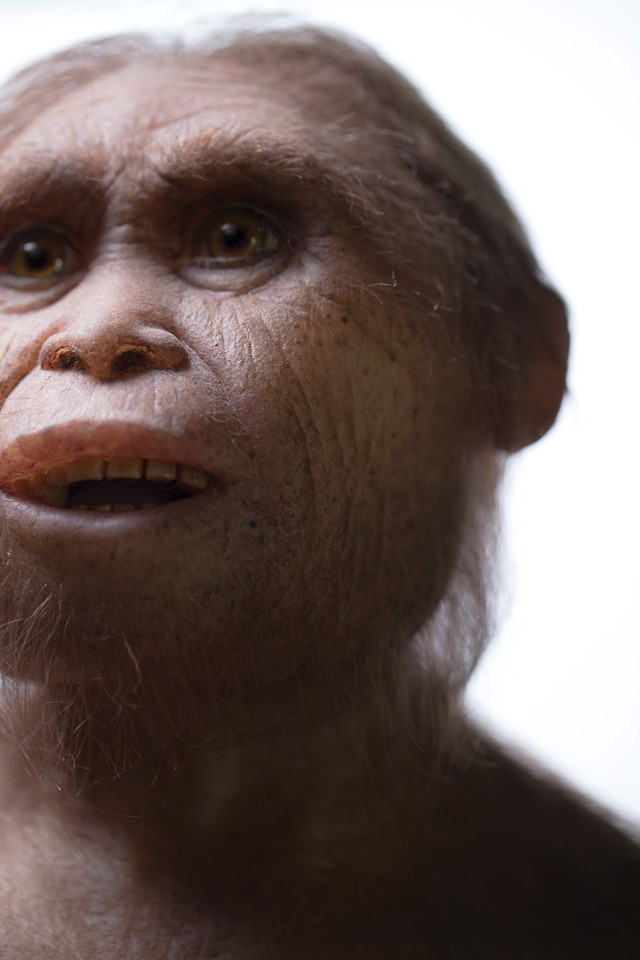
by Lucas Joel Monday, August 15, 2016

A reconstruction of Homo floresiensis by Atelier Elisabeth Daynes. Credit: Kinez Riza.
Since 2004, when scientists first announced the discovery of fossil remains of a new species of hominin from Indonesia — dubbed Homo floresiensis and nicknamed “hobbits” due to the species’ meter-tall stature — researchers have been trying to pinpoint exactly when H. floresiensis lived and when it died off. Several recent studies shed light on the topic.
Scientists previously suggested that H. floresiensis — known from fossil remains discovered in Liang Bua Cave on the island of Flores in 2003 — died off only about 12,000 years ago, timing that implied that H. floresiensis existed long after Homo sapiens reached the same part of the planet about 50,000 years ago. But according to a new study in Nature, the hobbits’ disappearance may have happened much earlier.
Researchers led by Thomas Sutikna of the University of Wollongong in Australia analyzed fossils and sediments containing those fossils, including volcanic ash layers, sampled during excavations at Liang Bua between 2007 and 2014, to arrive at the new age range of 100,000 to 60,000 years ago; meanwhile, artifacts associated with the hominins yielded ages between 190,000 and 50,000 years. The previous indication of the 12,000-year-old age relied on dating charcoal samples stratigraphically close to the remains of H. floresiensis, but not necessarily associated with the remains themselves.
H. floresiensis is the only extinct hominin known to have lived on Flores, but artifacts previously discovered on the island that date to between 800,000 and 1 million years ago point to earlier hominin habitation. And now, in two additional new studies published in Nature, researchers announced the discovery of hobbit-like hominin fossils found elsewhere on the island that are roughly 700,000 years old.
Scientists excavated the new fossils from a site 70 kilometers east of Liang Bua called Mata Menge, which is in a 400-square-kilometer “sedimentary depression containing … rock strata accumulated between 1.4 million years ago and 500,000 years ago,” said Adam Brumm — an archaeologist at Griffith University in Australia and lead author of one of the two studies — during a press briefing in June.
The new fossils include an adult jaw fragment that is smaller than the smallest H. floresiensis jaw known to date, as well as six teeth, including two infant “milk” teeth, from at least three different individuals. The fossils’ morphologies are very similar to those of H. floresiensis, and likely belonged to direct ancestors of H. floresiensis, according to the team.
Researchers need more fossil material to definitively assign the new remains to the H. floresiensis lineage, but the find nonetheless “sheds new light on the origins” of the hobbit, said paleontologist Gert van den Bergh, also of the University of Wollongong, a co-lead author on both studies. For one thing, he said, the fossils suggest hobbits evolved their small body size early in their history. One of the fossil teeth, a lower molar, “has characteristics that point to a Homo erectus ancestry,” he said, but is much smaller than “any known H. erectus molar.” H. erectus, another hominin species thought to have lived between about 1.9 million and 143,000 years ago, had migrated to the Flores region by about 1.6 million years ago. Although some scientists suggest that H. floresiensis descended from other hominins, like Homo habilis, van den Bergh said that the new molar “adds crucial support to previous claims that H. floresiensis is indeed a kind of dwarf H. erectus.”
The new remains, if confirmed, would extend the age range of the hobbit lineage, and may help researchers piece together why H. floresiensis became so small. Still, van den Bergh said, “a note of caution is warranted here: So far we have only recovered a small number of isolated fossils from Mata Menge, and more definite conclusions about the identity of the Mata Menge hominins and the origin and evolution of H. floresiensis must await the discovery of additional fossil remains, especially more complete portions of the skull.”
© 2008-2021. All rights reserved. Any copying, redistribution or retransmission of any of the contents of this service without the expressed written permission of the American Geosciences Institute is expressly prohibited. Click here for all copyright requests.